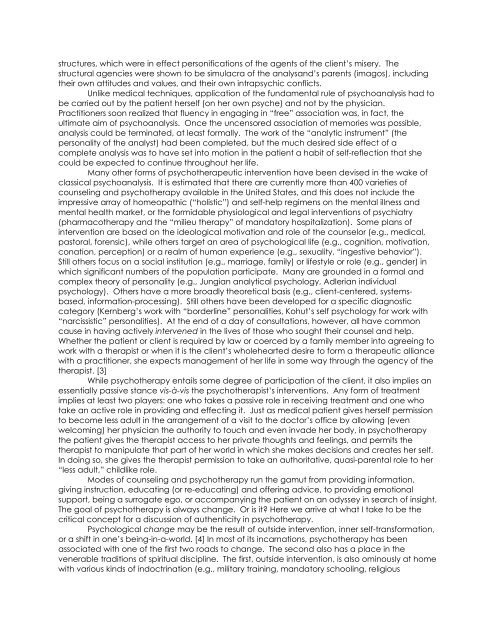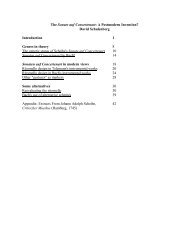SEVEN PAPERS ON EXISTENTIAL ANALYSIS ... - Wagner College
SEVEN PAPERS ON EXISTENTIAL ANALYSIS ... - Wagner College
SEVEN PAPERS ON EXISTENTIAL ANALYSIS ... - Wagner College
You also want an ePaper? Increase the reach of your titles
YUMPU automatically turns print PDFs into web optimized ePapers that Google loves.
structures, which were in effect personifications of the agents of the client’s misery. The<br />
structural agencies were shown to be simulacra of the analysand’s parents (imagos), including<br />
their own attitudes and values, and their own intrapsychic conflicts.<br />
Unlike medical techniques, application of the fundamental rule of psychoanalysis had to<br />
be carried out by the patient herself (on her own psyche) and not by the physician.<br />
Practitioners soon realized that fluency in engaging in “free” association was, in fact, the<br />
ultimate aim of psychoanalysis. Once the uncensored association of memories was possible,<br />
analysis could be terminated, at least formally. The work of the “analytic instrument” (the<br />
personality of the analyst) had been completed, but the much desired side effect of a<br />
complete analysis was to have set into motion in the patient a habit of self-reflection that she<br />
could be expected to continue throughout her life.<br />
Many other forms of psychotherapeutic intervention have been devised in the wake of<br />
classical psychoanalysis. It is estimated that there are currently more than 400 varieties of<br />
counseling and psychotherapy available in the United States, and this does not include the<br />
impressive array of homeopathic (“holistic”) and self-help regimens on the mental illness and<br />
mental health market, or the formidable physiological and legal interventions of psychiatry<br />
(pharmacotherapy and the “milieu therapy” of mandatory hospitalization). Some plans of<br />
intervention are based on the ideological motivation and role of the counselor (e.g., medical,<br />
pastoral, forensic), while others target an area of psychological life (e.g., cognition, motivation,<br />
conation, perception) or a realm of human experience (e.g., sexuality, “ingestive behavior”).<br />
Still others focus on a social institution (e.g., marriage, family) or lifestyle or role (e.g., gender) in<br />
which significant numbers of the population participate. Many are grounded in a formal and<br />
complex theory of personality (e.g., Jungian analytical psychology, Adlerian individual<br />
psychology). Others have a more broadly theoretical basis (e.g., client-centered, systemsbased,<br />
information-processing). Still others have been developed for a specific diagnostic<br />
category (Kernberg’s work with “borderline” personalities, Kohut’s self psychology for work with<br />
“narcissistic” personalities). At the end of a day of consultations, however, all have common<br />
cause in having actively intervened in the lives of those who sought their counsel and help.<br />
Whether the patient or client is required by law or coerced by a family member into agreeing to<br />
work with a therapist or when it is the client’s wholehearted desire to form a therapeutic alliance<br />
with a practitioner, she expects management of her life in some way through the agency of the<br />
therapist. [3]<br />
While psychotherapy entails some degree of participation of the client, it also implies an<br />
essentially passive stance vis-à-vis the psychotherapist’s interventions. Any form of treatment<br />
implies at least two players: one who takes a passive role in receiving treatment and one who<br />
take an active role in providing and effecting it. Just as medical patient gives herself permission<br />
to become less adult in the arrangement of a visit to the doctor’s office by allowing (even<br />
welcoming) her physician the authority to touch and even invade her body, in psychotherapy<br />
the patient gives the therapist access to her private thoughts and feelings, and permits the<br />
therapist to manipulate that part of her world in which she makes decisions and creates her self.<br />
In doing so, she gives the therapist permission to take an authoritative, quasi-parental role to her<br />
“less adult,” childlike role.<br />
Modes of counseling and psychotherapy run the gamut from providing information,<br />
giving instruction, educating (or re-educating) and offering advice, to providing emotional<br />
support, being a surrogate ego, or accompanying the patient on an odyssey in search of insight.<br />
The goal of psychotherapy is always change. Or is it? Here we arrive at what I take to be the<br />
critical concept for a discussion of authenticity in psychotherapy.<br />
Psychological change may be the result of outside intervention, inner self-transformation,<br />
or a shift in one’s being-in-a-world. [4] In most of its incarnations, psychotherapy has been<br />
associated with one of the first two roads to change. The second also has a place in the<br />
venerable traditions of spiritual discipline. The first, outside intervention, is also ominously at home<br />
with various kinds of indoctrination (e.g., military training, mandatory schooling, religious















